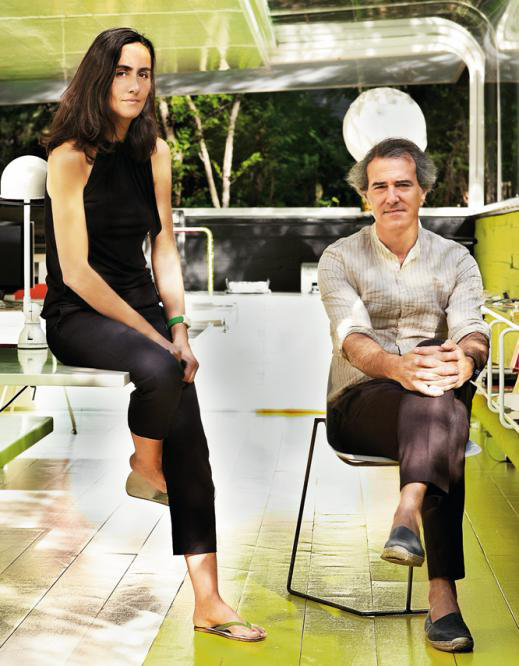Description of project by SelgasCano
The centre is on the boundary between the town and the country, in outskirts of Plasencia, the edge between what has been touched by a less artificial humanity and what has been touched by millennia of climate. What has been touched by humanity has covered up those millennia with the sweep of a trowel in a few years. This is strange, even economically, because to do so, 15m high retainer walls had to be built. Thus, from the outset, from the competition design, we saw quite clearly that the work consisted of choosing between one of the boundary´s two sides: belonging to the city, to what has been touched by our generation, or belonging to slowness. Under these conditions it was impossible to belong to both.
Having been chosen by the second option, we found ourselves forced to rest the buildings on a much lower level then the street due to the considerable height difference between the two worlds. The artificial world had created a 17 m high embankment that covered the natural contours , now buried below. In reaction to this unstoppable submission (sous les paves, les 17 metres de paves, la plage), we decided that our solution would have a maximum respect for the land, resting on and covering the least possible area of the allotment.
We plotted to make this building set the stage for a different method and preserve an island of natural earth in the future expansion zone, even if it meant being a small puddle in the sea, as a possible reagent for the rest of the constructions to come, which will find themselves insinuated and become beached similarly in this whiffed sea: the Extremdura countryside used as an equivalent for the ocean.
Forget-me-not. We like the name of the flower, and also the fact that it is a flower. The Salamanca highway, the former Silver Route and the future Silver Motorway as well, all run past the western side of the allotment, which also has the best views of the Gata Range.
The building will be visible in the distance from an entire western perspective, from north to south. It will be seen when passing by at high speed in a car, which is why we have planned it as a snapshot or a luminous form, acting as a sign for passengers by day and by night, playing at being a correspondence between sensation and reality, between the position it seems to be heading for and the position from where it will move.
Forget-me-not…tell me if its final aspect triggers in you the same reminder as George Sand´s for Flaubert, “ Do not define the form, don´t bother…” The form of ours is due to the building´s section; due, as we have said, to the idea of resting the smallest possible part on the ground, which corresponds to the stage area and the tiers in the main hall. The section of this hall is what continues to define and complete the form by superimposing the rest of the brief on top of it: the entrance lobby, the secondary hall for 300 people, which can be divided into three for 100 spectators each, the exhibition halls and the restaurant area.
The entrance is on the urbanized street level, more than 17 meters above the lowest part of the building, using an orange gangway that arrives at a 12m deep vertical canyon in the same colour, where the views of the countryside, the spurs of the Gata Range, are accentuated. From here it is possible to move all around the central concrete shell, go up or down on a set of ramps and spiral stairs that mingle exterior and interior spaces. This is for two reasons, economy and expenditure. Economy by not climatising or using glass to enclose certain parts. Expenditure due to a crossing of spaces –in-out-in on account of the mixture of their climates.
A few years ago, Selgascano was commissioned to create an auditorium in a singular site, just outside the city of Plasencia. The site is on the edge of the city, on the border between the city and the countryside, between the sadly artificial and the natural. The project is, now, shortlisted for the EU Mies Award 2019.
The project designed by SelgasCano is located on the edge of the city, in an area of new suburban expansion, is designed in an almost impossible place, with a vertical difference of height of more than 15 m. These two conditions: an anodyne environment, a sea of suburbanization, against the force of nature the countryside of Extremadura, an equivalent to an ocean interior and the physical conditions of the plot, were decisive to generate a piece, that tries be a revulsive, face to the low quality of the architecture built during those years.
More information
Published on:
February 1, 2019
Cite:
"Plasencia Auditorium and Congress Center by SelgasCano" METALOCUS.
Accessed
<https://www.metalocus.es/en/news/plasencia-auditorium-and-congress-center-selgascano>
ISSN 1139-6415
Loading content ...
Loading content ...
Loading content ...
Loading content ...
Loading content ...
Loading content ...
Loading content ...
Loading content ...
Loading content ...
Loading content ...
Loading content ...
Loading content ...
Loading content ...
Loading content ...
Loading content ...
Loading content ...
Loading content ...
Loading content ...
Loading content ...
Loading content ...
Loading content ...
Loading content ...
Loading content ...
Loading content ...
Loading content ...
Loading content ...
Loading content ...
Loading content ...
Loading content ...
Loading content ...
Loading content ...
Loading content ...
Loading content ...
Loading content ...
Loading content ...
Loading content ...
Loading content ...
Loading content ...
Loading content ...
Loading content ...
Loading content ...
Loading content ...
Loading content ...
Loading content ...
Loading content ...
Loading content ...
Loading content ...
Loading content ...
Loading content ...
Loading content ...
Loading content ...
Loading content ...
Loading content ...
Loading content ...


























































